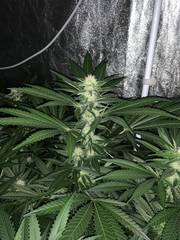-
Posts
280 -
Joined
-
Days Won
4
Content Type
Profiles
Forums
Calendar
Gallery
Articles
420 Directory
Classifieds
Posts posted by Budwizer
-
-
-
Cable ties and in Series bud
Sent from my GT-I9505 using Tapatalk
Yo JH420
Are you sure about that? If you wired them in series, if one stops working, they all stop working. Series would be where you left the neutral wire unbroken, all along the path, and broke the live wire at each bulb, connecting the two open ends of the broken live to the bulb. Then, you’ll have joined the live and neutral at the end.
Wired in parallel, if one bulb stops working, the others will not be affected. Think of the live and neutral as the two rails of a railway line. Imagine yourself and 11 friends as bulbs, each standing on the railway line with one leg on each rail. That would be a parallel connection. If you jump off, the others are still connected to both rails.
Using the railway line example for series connection would be you and your friends standing with both legs on one rail, with the line cut between your feet. If one jumps off, the line is broken.
-
That looks lekke Cereal!
Perfect utilization of the space!
Of course you know what’ll happen the moment you add a Veg section- your next crop will stretch like mofos, and have you pulling your hair out!


-
Parallel
-
Yo Budwizer, can you elaborate more on what you meant by this.Ya, 6000 lux isn’t that much, but then you gotta remember that’s only 20watt, which blows my mind. I’m telling you- if you can pull 20 grams of half decent dry bud under that light, I’m going to have to rethink my lighting strategy.
As GLO touched on, you can expect around 0,5 gram per watt. Sorry bud, but those be the facts.
Thus, what I meant was: if you pull a gram per watt, of even airy, popcornish dry bud, then you’ve sold me, and I will invest time and effort and money in similar lighting for my future grows. You will have proven to me, that further investigation into using these lights is worth it.
-
That’s almost impossible to say- depends on too many things, but I’m unhappy if I don’t pull at least 60 gram per plant (close to 2oz). Best I’ve gotten was 100 gram per plant under 600watt. That was four plants in a very tight space.
-
I can’t comment on the longevity of those floodlights, mine only gets used as emergency lighting. How’s your experience with reliability?
-
Ya, 6000 lux isn’t that much, but then you gotta remember that’s only 20watt, which blows my mind. I’m telling you- if you can pull 20 grams of half decent dry bud under that light, I’m going to have to rethink my lighting strategy.
-
Man I still can’t get over the fact you’re getting those results under that 20 watt led! It just doesn’t make sense dude!
I have measured the PAR of a similar 10 watt led floodlight I have- and real close it puts out 4000 mmol/m2/s! It diminishes real quick though as you move further away. You could buy 20 of those 20w led floodlights for the price of a digital 600watt setup (incl reflector) and then pull only 400watt!
I’m really interested to see how you yield with that light.
-
I’m gonna say running a 400watt bulb on the 400watt setting is absolutely safe. I’ve done the same thing with a 250watt bulb.
I think running a 600watt bulb at 400watt might work, but again, hurts lifespan.
-
I know running higher wattage than what’s rated on the bulb shortens the bulbs lifespan.
Just realized that someone may misconstrue what I meant here- I’m talking specifically about the “boost/ super lumen” feature on some digital ballasts. This setting will for example push 630watt to a 600watt bulb, and shorten the bulbs lifespan. I’m totally with GLO on not running a 400watt bulb on the 600watt setting. You WILL make kak!
-
Hey 420sa
I also didn’t know you can do that, until another forum member posted something about it a while back. I’m not sure, but I think doing it that way around would be fine. I know running higher wattage than what’s rated on the bulb shortens the bulbs lifespan.
That’s a damn handy feature of digitals.
-
Love to see her explode in that new pot!
Keep those pics coming!
Sent from my iPhone using Tapatalk
-
Wow Totemic
Looking healthy for outdoors hey!
She’s gonna get massive in that 100lt pot.
-
-
BTi is the bees knees for fungus gnats dudes:
https://en.m.wikipedia.org/wiki/Bacillus_thuringiensis_israelensis
https://hydroponic.co.za/hydroponics/margaret-roberts-biological-mosquito-insecticide/
-
Sorry Zairek
Hijacked your thread a little there.
Mods please move if you want.
-
-
Pretty much yes. It’s not unusual to slowly raise your input pH, as the buffer in the soil is used up, over the grow timeframe. It depends on your soil strategy: transplant once, and you’re gonna have used up the buffer by the end of the grow. Transplant twice, and you’re able to replenish the buffer. Put too much lime in the soil, and you’ll have to go in very acidic to counter the alkalinity, but then, you’re going to release too much calcium, which will lock out K.
Please remember, the above is just a basic outline explanation. It’s just to give you an idea of what’s going on in soil. It’s also just about the limit of my understanding on the subject. The best strategy is always to change things slowly, and not overdo anything.
-
I use only BTi for fungus gnats. No pyrol, no neem, nada. I don’t let my pets in the room, and I get changed before I enter my room, if I’ve been in the garden. I vacuum the room and tent out once a week.
-
This is a little complicated bud- you’re gonna have to do some reading on your own, but here’s a quick rundown:( this is a hypothetical example) if your soil is buffered at 6.8, you feed at 6.0. The acidity causes a reaction in your soil, freeing calcium, magnesium, phosphorus, potassium etc. from the various sources in the soil. The pH slowly increases to your soils buffer value over a day or so, thus allowing the plant to take up these nutrients at the pH they are best absorbed. Each time you do this, you’re using up some of the alkalinity in the soil, and slowly the soil starts getting more acidic.
This is why some people measure runoff pH. It tells them how much buffering potential is in the soil. Example: if you water at 6.0 and the runoff is 6.5, you can safely assume you’re soil pH is above 6.5, probably around 6.8.
If you water at 6.0 and the runoff is 6.0, then the soil has no buffer, and you will run into deficiencies, because some nutrients are best absorbed at 6.5 pH etc. Also, as you continue to feed at 6.0, the soil will become more acidic, and the plant will ultimately be unable to take up nutrients in the 6.0 to 7.0 range ( basically everything)
Like I said, just a quick explanation.
-
Ok, now I understand. If you’ve had the light plant for three weeks already, then we’ll done, you’re on the right track to bringing her back. All she needs is a little more N. Keep the same schedule you’ve been using, but add a little more N fertiliser to that plant.
-
Molasses, kelpak & EM- all good, but I would correct pH to 6.2.
-
Hey Guys and Gals.
So I have 2 Royal Gorilla strains, one has started to recover from the mites and the other was given *what??* recently. As you can see there is a vast difference in colour, I replaced the soil about 10 days ago as part of the attempt to get them through the mites. Over and above just waiting and hoping they eventually come right what would you all suggest I could add to assist along the way.
Thanks All.
Looks to me they’re both recovering well. Give them both some more time. Common mistake to overreact.





First Time Grower - All welcome and A helping hand will do.
in Indoor Growing
Posted
You’ve done an awesome job there JH420!!
Pity you have to waste your time at the rugby. Everyone knows the lions will kick ass, again.